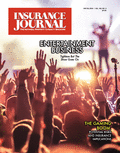The performance of the commercial automobile segment continued to deteriorate through third quarter 2017, according to a new A.M. Best report.
Commercial auto has been a sore spot in the property/casualty for several years. Commercial auto insurers have tried to address unfavorable results by enhancing underwriting measures and aggressively raising rates to improve rate adequacy.
“After six straight quarters of rate decreases, insurers began responding to the negative underwriting pressure with rate increases in the third quarter of 2011,” the report said. “Stung by adverse reserve development at the end of 2011 (after five years of favorable development), companies recognized that the pricing levels were inadequate and began pushing average rates in the sector upward at a growing pace, which continued through third quarter 2017.”
Despite these changes, commercial automobile lags the overall commercial lines group and continues to underperform the P/C market as a whole, according to A.M. Best market segment report, “Commercial Automobile Sector Struggling to Keep Pace.”
“Adverse reserve development has contributed to consistent increases in net underwriting losses over the past six years, but insurers initially appeared slow to react as loss trends outpaced rate increases, and commercial auto underwriting losses grew from $744.8 million in 2011 to slightly over $2.9 billion in 2016,” the report revealed. “In addition, owing to the lag before results fully recognize premium price increases, profitability remains pressured, and, as loss costs rise, insurers are stuck playing catch-up.”
More vehicles on the road thanks to a rebounding economy and additional miles driven are adding to the troubling trend as well as the continued trend of distracted drivers on roadways today.
“The difficulties of underwriting commercial auto are being compounded by rising claims frequency owing to more commercial vehicles being on the road as the economy rebounded following the recession; the record growth in miles driven; and an increase in distracted driving,” A.M. Best said.
Rising vehicle repair and medical costs are also driving up claims severity.
“After lagging by several quarters, insurers have made concerted efforts to raise rates, but have been unable to stop the bleeding,” the report said.
Reversing the unfavorable results in commercial auto will be an uphill task for the industry. A.M. Best notes that to change the trend, the industry will have to be more discriminating when it comes to risk selection, prudent reserving, and appropriate pricing.
“On the positive side, the results of the aggressive rate increases — particularly over the last two years — should start manifesting over the near term,” the report said.
The commercial auto line continues to have a negative impact on the industry’s bottom line results, even as profitability and capital adequacy for the commercial lines overall remain intact, according to the report. To restore stability, companies have raised average rates each year since 2011.”
However, the report noted that while the rate increases over the last few years have been larger, it will take time before the impact is fully recognized in results.
“A discernible improvement in profitability, however, is unlikely until the severity and frequency of accidents decline, and underwriting improves,” the report said. “Frequency and severity may continue to rise in line with economic growth, which the use of more detail-focused underwriting (using effective loss control and risk management techniques), in addition to continued rate increases, could help mitigate.”
Expect more pain before relief, however. “[T]here will be more pain — owing to factors such as distracted driving and attorney involvement — before insurers realize any long-term gains from focused underwriting and pricing efforts.”
Report Highlights:
- Accident year reserves for 2015 rose 5.8 percent from 12 to 24 months of development, which may have triggered rate increases in 2017, which were larger than in previous quarters.
- The calendar year combined ratio increased sizably, to 110.4 percent in 2016 from 94 percent in 2007. The loss and loss adjustment expense ratio, which rose 27 percent in 10 years, due to both adverse reserve development and inadequate pricing, has been the main contributor to the deterioration in the combined ratio.
- Average rates increased by 5.4 percent, 6.1 percent, and 7.3 percent in the first three quarters of 2017—the largest quarterly consecutive increases—as insurers worked to offset the rise in losses and improve profitability. A.M. Best noted that “whether the increases will be enough to reverse the trend in underwriting losses is still too early to tell.”
Source: A.M. Best
Topics Carriers Auto Commercial Lines Business Å˽ðÁ«´«Ã½Ó³» Underwriting AM Best Property Casualty
Was this article valuable?
Here are more articles you may enjoy.



 Where the AI Risks Are: Swiss Re’s Top 10 Ranking by Industry
Where the AI Risks Are: Swiss Re’s Top 10 Ranking by Industry  US Home Insurers Post Net Combined Ratio Over 110: S&P
US Home Insurers Post Net Combined Ratio Over 110: S&P  North Carolina Will Soon Have Some of the Highest Auto Liability Minimums
North Carolina Will Soon Have Some of the Highest Auto Liability Minimums  AIG Drops Claims Against Former Execs Who Started Dellwood Å˽ðÁ«´«Ã½Ó³»
AIG Drops Claims Against Former Execs Who Started Dellwood Å˽ðÁ«´«Ã½Ó³» 

